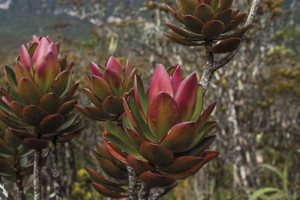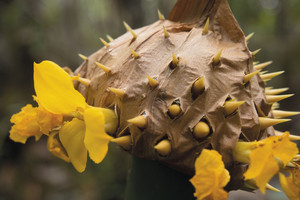
Ricardo Azoury
The Serra do Imeri mountains of Amazonas State form the setting for Neblina Peak…Ricardo AzouryAlthough it is commonly envisioned as a green carpet covering a vast flat expanse, Amazonia possesses a peculiar, less well-known topography: mountains that range in elevation from 800 to 3,000 meters. To biologists, these imposing, seemingly immutable massifs are living laboratories that are undergoing constant transformation. In this setting, large numbers and varieties of species emerge, live, reproduce, migrate and disappear. Groups of researchers from different Brazilian institutions are helping to paint a truer picture of the flora of this mountainous region of Amazonia, and some of the brushstrokes of the painting can now be appreciated. More than two dozen new plant species—mainly flowering plants—have been discovered during a series of expeditions made in recent years and are now being described in the scientific literature.
Between 2011 and 2014, five biologists from the Rio de Janeiro Botanical Garden (JBRJ) explored remote areas on the Brazilian side of the Guiana Shield, a geological formation that encompasses Guyana, Suriname, French Guiana, much of Venezuela and a small portion of extreme northern Brazil. Enduring extreme climates and lengthy trips, the researchers visited the Serra do Aracá mountains and Neblina Peak in the state of Amazonas, and the Serra Grande mountains and Mount Caburaí in Roraima State, as they hiked over rocks and swampy terrain without the benefit of trails, gathering plants in gullies, brush vegetation and hollows. These highlands, formed of mountain ranges with craggy peaks or elevated mesas known by their indigenous name tepui, are home to vegetation quite distinct from what grows on the vast Amazonian plain.

Ricardo Azoury
…where the team from the Rio de Janeiro Botanical Garden identified the shrubs Bonnetia neblinae…Ricardo AzouryIn the lowlands at elevations of up to 500 meters, the predominant vegetation consists of tall, dense forest, while the flora in the mountains and the tepuis recalls the rupestrian grasslands found in the mountainous areas of the states of Minas Gerais and Bahia. Part of this previously all but unexplored botanical universe is beginning to be revealed.
On these expeditions, the researchers collected nearly 4,000 plant samples. To date, some 60 new occurrences of vascular plants that had previously been observed only in neighboring countries have been recorded in Brazilian territory. At least 10 new species, including bryophytes and flowering plants, have been or are being described. Aracá was the only tepui for which there was an earlier list of plants, containing records of about 250 species, published in 1992 by British botanist Ghillean Tolmie Prance and American botanist David Johnson. The two arranged expeditions to the region in the 1990s. “We were able to expand their list with our collected samples of about 450 newly identified vascular plant species obtained just from that one part of the highlands,” says botanist Rafaela Campostrini Forzza, excitedly. She is curator of the JBRJ Herbarium and a member of the expeditions.

Ricardo Azoury
…and Leandra maguireRicardo AzouryAracá, also a tepui
The families, genera and numerous species found at Aracá are the same ones that predominate on the other tepuis of the Guiana Shield. “A few studies questioned whether Aracá was a tepui, because it is quite far from the original area and is a lower mountain with surrounding vegetation that grows closer to the summit. But our work showed that the floristic composition at the top is typical of tepuis,” Forzza says.
Reaching the tepuis in this region is not an easy task; it requires complex logistics involving air, ground and water transportation, as well as help from local assistants. Of the three expeditions to the Serra do Aracá, the first—and more exploratory—and the third were done on foot. “We flew from Rio to Manaus, where a van took us to Novo Airão in Amazonas State. From there, we caught a ship, then a motorboat to the base of Aracá, and from that point we walked to the top,” recalls botanist Gustavo Martinelli, coordinator of the National Center for Plant Conservation at JBRJ and one of the researchers on the team that explored the mountains.

Ricardo Azoury
On Mount Caburaí in Roraima State, the northernmost point in Brazil, the botanists use the camp’s laboratory to analyze the material collected during the dayRicardo Azoury“It’s not just a difficult hike,” Forzza observes. “We climbed with heavy equipment, silica gel, alcohol, journals, food, tents and other supplies, and we came back down loaded with sacks and sacks of plants, as pressed and bound up samples,” she says. “It was tough.”
The second expedition to Aracá and the others to other mountains were made by helicopter, thanks to sponsorship by Natura, a cosmetics firm that supported the research. “At Aracá, the helicopter stayed at a village in the municipality of Barcelos, flew two groups up to distant points in the mountains—trips that would be very difficult to make on foot—and brought them back down in the late afternoons,” the botanist says. “This enabled us to collect a larger number of samples. To climb Neblina Peak on foot, for example, would have taken us three to four days in the rain and cold weather.”

Ricardo Azoury
Saxofridericia regalis, commonly seen in the highlands of Venezuela, Guyana, Suriname and French Guiana and now found on Mount CaburaíRicardo AzouryAt the top of the Serra da Mocidade
In January and February 2016, a multi-institutional expedition coordinated by the National Institute for Research on the Amazon (INPA) set out to map the characteristic plant species of the Serra da Mocidade mountains, located in the national park of the same name, in the state of Roraima. The team of botanists led by Alberto Vicentini was able to collect 395 plant samples, including mosses, tree ferns, lycophytes, liverwort, Anthoceros, gymnosperms and angiosperms.
“The list is still very preliminary and the data need to be interpreted carefully,” notes botanist Ricardo Perdiz, a doctoral candidate at INPA who took part in the expedition. “But, considering just the collections made at the Serra da Mocidade National Park Conservation Unit, which total about a thousand samples, we’ve now identified 557 species, 321 genera and 134 families of plants,” Perdiz reports.

Ricardo Azoury
Sphagnum aciphyllum moss…Ricardo AzouryPerdiz points out that the number of plants collected is still considered too modest to convey an approximate idea of the floral abundance in the region. “If we analyze these data by type of plant, we’ll realize how much we still need to collect and learn,” he says. “And if we examine the distribution of the samples in geographic space, we’ll see too that there are a lot of gaps, given the fact that there are areas in which not even a single sample was collected.”
Since the data are being analyzed, the researchers cannot yet give any accurate information about the plants they collected, but they hope to identify a large number of endemic species that exist only in that region.” “Hilltops are geographically separated, so we can infer that they host isolated populations,” Perdiz theorizes. “We suspect that, among the plants collected at the top of one of the Mocidade hills, there are 11 new species.”

Ricardo Azoury
…and the carnivorous plant Drosera roraimae, both found in the Serra do Aracá mountainsRicardo AzouryTwo new species of bryophytes in the Serra da Mocidade have already been described. A third species of Dacryodes, from the family Burseraceae, which includes myrrh and incense, is expected to be published by the end of 2017. The expedition coordinated by INPA also facilitated the identification of four new records in Brazil of flowering plants—all collected at elevations above one thousand meters—that had been known to exist only in neighboring countries.
The JBRJ expeditions were documented in a video entitled Montanhas da Amazônia: Em busca da flora desconhecida [Mountains of Amazonia: In search of the unknown flora] and in the book Expedições às montanhas da Amazônia [Expeditions to the mountains of Amazonia], published in 2015. The exploratory expeditions coordinated by INPA, which were intended to collect samples of insects and the fauna of the Serra da Mocidade in addition to plants, gave rise to the documentary Expedição novas species [New species expedition], currently being finalized.
Republish